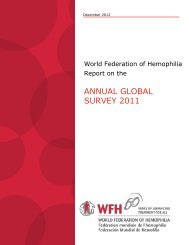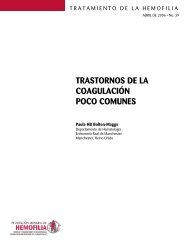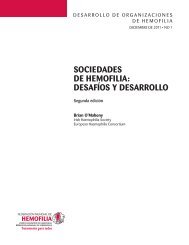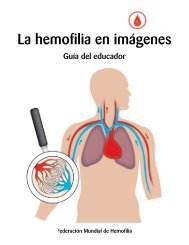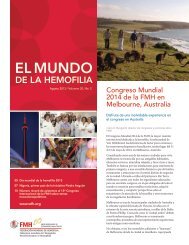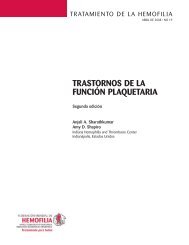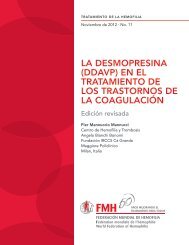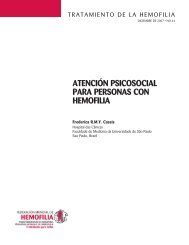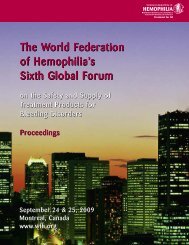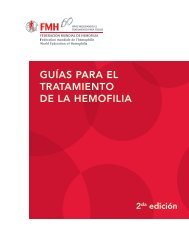Guide for the Assessment of Clotting Factor Concentrates
Guide for the Assessment of Clotting Factor Concentrates
Guide for the Assessment of Clotting Factor Concentrates
Create successful ePaper yourself
Turn your PDF publications into a flip-book with our unique Google optimized e-Paper software.
SECTION 5SAFETY ASPECTS OF LOCALLY MADE SMALL POOLCRYOPRECIPITATEIntroductionSome blood centres with links to <strong>the</strong> local hemophilia community produce coagulation factor concentratesin-house. This practice has largely ended in developed countries since large pharmaceutical plantshave started manufacturing concentrates. However, it is still done in developing countries and provides<strong>the</strong> main source <strong>of</strong> product <strong>for</strong> treating hemophilia A in a number <strong>of</strong> countries, including Cuba andThailand. For this reason it is relevant to assess such products in terms <strong>of</strong> <strong>the</strong> quality and safety issueswhich authorities need to be aware <strong>of</strong>. It should be reiterated that <strong>the</strong> products <strong>of</strong> choice <strong>for</strong> <strong>the</strong> treatment<strong>of</strong> hemophilia are concentrates manufactured by accredited pharmaceutical fractionators subject to <strong>the</strong>full range <strong>of</strong> regulatory and quality control measures.Products availableThe most important product in this category is small pool cryoprecipitate <strong>for</strong> <strong>the</strong> treatment <strong>of</strong>hemophilia A. The technology required to produce this product is relatively modest, although it canbecome more complex and demanding as refinements are introduced. Cryoprecipitate <strong>for</strong>ms whenfrozen plasma is thawed at temperatures which do not exceed approximately 4 o C. Under <strong>the</strong>se conditions,a proportion <strong>of</strong> <strong>the</strong> plasma proteins remains insoluble and can be separated from <strong>the</strong> rest <strong>of</strong> <strong>the</strong> thawedplasma. The insoluble protein is called cryoprecipitate (cryo) and is mostly composed <strong>of</strong> <strong>the</strong> cold-insolubleproteins fibrinogen and fibronectin. When <strong>the</strong> plasma is frozen under conditions which preserve factorVIII activity, <strong>the</strong> cryoprecipitate is also enriched in factor VIII. This process is still used by pharmaceuticalcompanies to extract factor VIII <strong>for</strong> <strong>the</strong> large-scale manufacture <strong>of</strong> factor VIII concentrates.Cryoprecipitate produced in blood centres may be used <strong>for</strong> <strong>the</strong>rapy without fur<strong>the</strong>r modification.However, to make its use more convenient <strong>for</strong> patients, it may be subjected to fur<strong>the</strong>r processing, suchas freeze-drying. The production <strong>of</strong> cryoprecipitate is summarized in Figure 2. Whole blood and plasmacollected by plasmapheresis can be used to produce cryo.The production <strong>of</strong> cryo has been studied <strong>for</strong> many years. The variables which influence <strong>the</strong> amount <strong>of</strong>factor VIII present in <strong>the</strong> cryo (<strong>the</strong> yield) are well understood. With careful attention to maximize <strong>the</strong>amount <strong>of</strong> factor VIII in <strong>the</strong> cryo, about 600 units <strong>of</strong> factor VIII can be harvested from one litre <strong>of</strong> plasma.The final product is a freeze-dried concentrate which people with hemophilia can store in householdfridges and reconstitute and administer <strong>the</strong>mselves.<strong>Guide</strong> <strong>for</strong> <strong>the</strong> <strong>Assessment</strong> <strong>of</strong> <strong>Clotting</strong> <strong>Factor</strong> <strong>Concentrates</strong> 27



